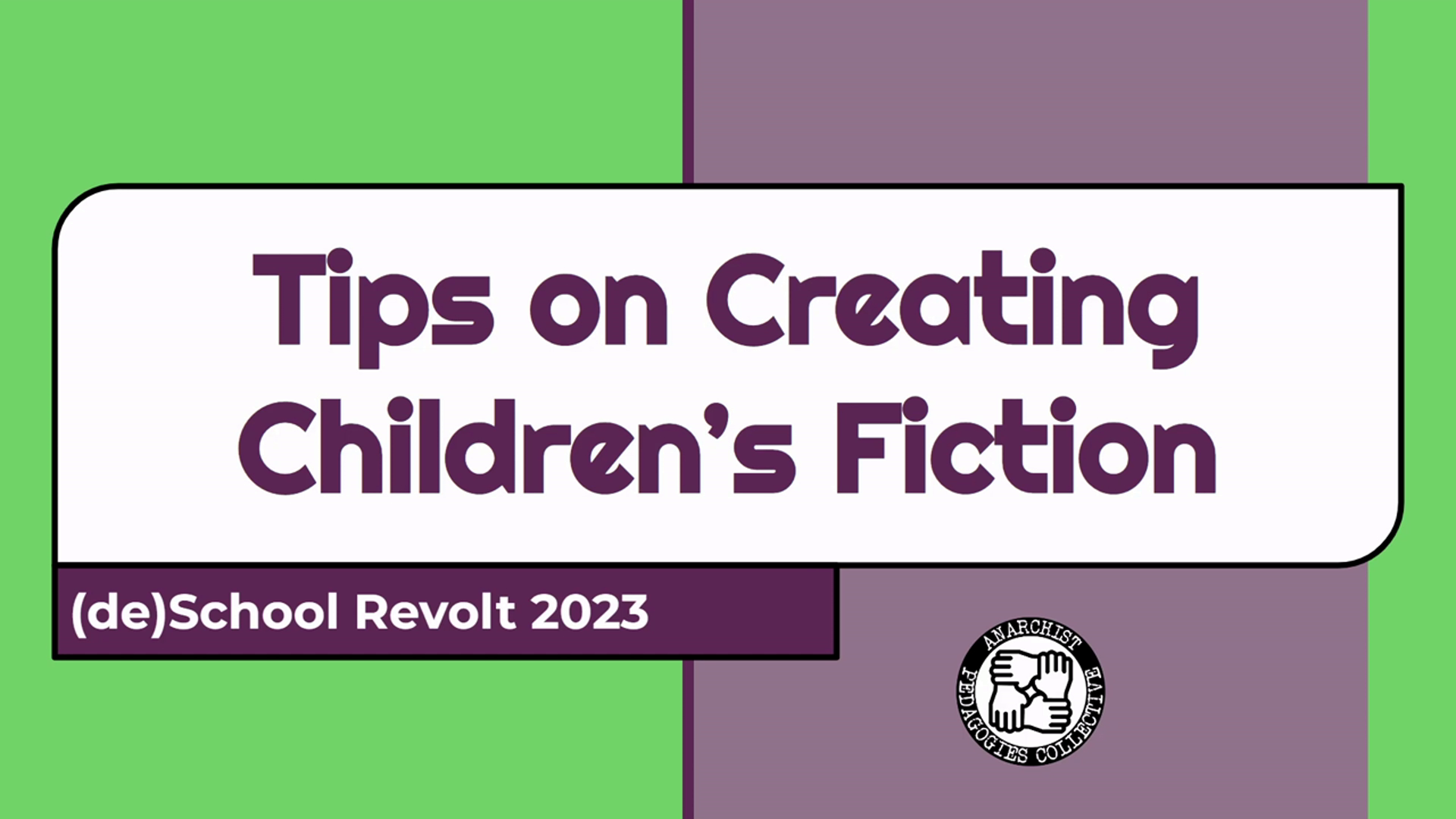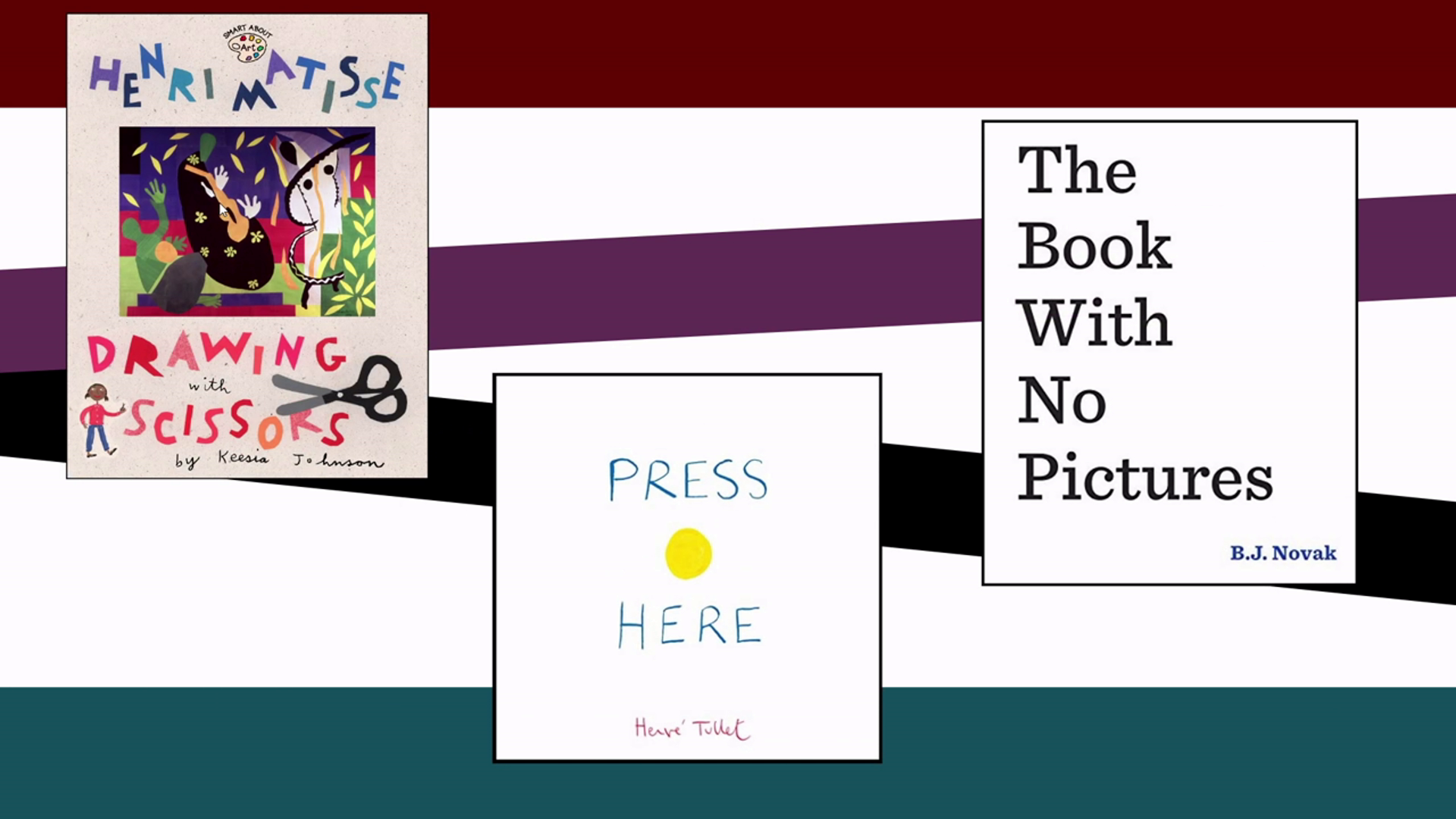
Tips on Creating Children's Fiction
This is a full transcript that is part of this video [PeerTube]. The PDF of the presentation is available here.
For this year’s School Revolt, we wanted to open up the space to create and share stories of any kind. Part of the impetus for this was wanting to find ways to build stories for or by kids, especially because it doesn’t really seem like there are very many currently available. So to help facilitate that, I’d like to give some tips on creating children’s fiction, particularly with a focus on younger kids.
When creating children’s fiction, we need to consider the contexts in which they’re read.
Some of the contexts that I want to focus on include the following:
- First, children will generally flip through the book and look at the visuals to see if the story interests them or if there are interesting elements to the story that they want to explore.
- Next, children use the relationship between both the text and the visual information in order to thoroughly understand the story.
- Third, first read-throughs of printed stories are often done in the company of someone else, generally a person older than they are.
- And finally, children revisit the same stories over and over as they grow, and they often have new takeaways every time.
Since this media is for children, there is a tendency of adults to use overly simplistic language. This doesn’t have to be the case, and this is mostly because children are reading something both visually and collectively. It’s best if the language is somewhat basic and clear, but it doesn’t always need to be hyper-simplified. This also gives a good space to discuss vocabulary when the books are being read with someone else.
This is because the stories that are told to children are also part of how they learn language. As they engage in learning emotional and social lessons, they’re also building up ways to discuss certain topics and what words they can use to describe how they’re feeling, what they’re seeing, or how they understand something.
If children are reading together, they can discuss what it means and point to the images to determine that. If they’re reading with adults, someone is there who can describe what it means. They often pause to ask questions or discuss topics and pictures. Reading is a very social activity for children (and it’s worth considering that, perhaps, we should be seeing it as a social activity for adults, too).
Second, the visuals and the text rely upon each other. You can do a lot with the images that you use, like building upon the story that you’ve written by incorporating them into the way you tell stories. It’s also very helpful because you can add details that you wanted to include in the written text but felt made it too bogged down. It’s not necessary to be explicit in the text, but you can make your ideas more explicit in the images!
You can also use your images to clarify the text. No new information has to be provided, and you can just have your images follow the text that you’ve written. This is sometimes a great tactic for books that are highly interactive, like pop-up books. It can help make it easier to guide people through stories, making sure that they’ve followed (or can recognise) the pathway that you intended.
But it’s also worth remembering that you can always do both. Mix it all up, play with what you want, do what you feel is best! The most important thing is that everyone has fun with it.
Similarly, you should also have fun with design and format. There are so many ways to do something, and kids all have wildly different preferences. There’s no one correct way to do something. You could use watercolours or photographs. You can focus on simple images and more complicated instructions. You can refuse to use any images at all and focus entirely on text format.
Sometimes you might want to make everything really clear and obviously understood because that’s important to the message you’re trying to convey. But other times you might want to use elements that initially feel confusing or obtuse to create other connections! As long as it’s fun and engaging, as long as it’s something people can figure out over time, you can do almost anything.
At this point, I want to share some examples of children’s books that I really like because of how their text and visuals work together. These aren’t ‘anarchist’ books in any capacity, but they have elements that I really enjoy and think can be pretty fun to think about.

First, I want to talk about Keesia Johnson’s Henri Matisse: Drawing with Scissors. It has such a mix of visual information through it, with so many of Henri Matisse’s artwork being strewn throughout it. There are photographs and a range of illustrations. Sometimes it feels like an art museum that’s been placed within the pages of a book. Sometimes there’s a feeling that it’s like a scrapbook, and this is actually helped by the text. It mixes images into it, but it also just feels like parts of it could be diary entries.
Next, BJ Novak’s The Book With No Pictures is delightful because it focuses on creating something in a visual medium without any illustrations at all. It uses font colours, styles, and sizes to convey its very simple message. There’s nothing super complex about this except for the fact that it’s a bunch of silly words that are meant to be ‘embarrassing’ and funny. Instead of relying completely on illustrations, it pushes people reading it to use their voice and read it out loud because that is where the book really shines.
The last example I have is Hervé Tullet’s Press Here. It’s a completely interactive book of instructions, though it doesn’t necessarily feel that way because the point is for it to be a game. It uses a lot of basic colours to act as ‘buttons’ and ‘switches’ within the confines of the story, prompting children to play with the book as they read it. Something like this definitely creates a space where people would get more entertainment out of reading it together.
There are a lot more examples of interesting concepts in children’s books, but these were just a few that I remembered really having fun with when reading with kids.
The last tip, as I’ve repeatedly said throughout this, is that children’s stories are meant to be shared experiences. They’re meant to be communal, to give children opportunities to learn from, with, and about their communities. They’re meant to be spaces for everyone to explore different concepts by prompting children to ask questions, even if those questions aren’t comfortable for adults. The point is to discuss and communicate about what’s being seen and interacted with and what’s being learned from it, rather than just simply making something “for” children.
This is why there are occasionally references to things adults will understand but will go over the heads of children, and they’re often so skillfully added that it doesn’t disrupt the experience for anyone. You could have a tiny alien constantly appearing in every panel of a picture book about David Bowie, jokes at the expense of politicians hidden in the background of an image… These things help build amusement for adults to help keep them engaged, too.
But the point is that we want to share these experiences. Not only does this help a child learn about their community, but it builds and maintains relationships with the people around them.
Reading together, regardless of age, does that brilliantly. You can stop and discuss, sharing perspectives and connections, frustrations, anything. It creates a space to talk openly, to ask questions, and to learn from more than the text: we can learn from each other.
Overall, we hope that everyone just has fun with whatever they’re doing. Do what feels right, do what you enjoy, play around with whatever you can. Nothing will ever be perfect, but it’s always worth trying to create something fun and interesting.
We can’t wait to see what you create!